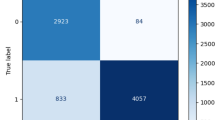Abstract
In this paper, the authors evaluate the effectiveness of Statement of Cash Flows measures in the classification and prediction of bankruptcy. The problems of biased estimators and bankruptcy probabilities and of optimal cut-off rates are addressed by using a large random sample and conditional marginal probability density functions. It is found that cashflow variables provide statistically better classification and prediction rates when used with traditional accounting variables when bankruptcy is defined as a Chapter 11 filing.
Similar content being viewed by others

References
Altman, Edward I. “Financial Ratios, Discriminant Analysis, and the Prediction of Corporate Bankruptcy.”Journal of Finance 23, no. 4 (September 1968): 589–609.
—. “Commercial Bank Lending: Process, Credit Scoring, and Costs of Errors in Lending.”Journal of Financial and Quantitative Analysis 15, no. 4 (November 1980): 813–832.
Aziz, Abdul, andGerald H. Lawson. “Cash Flow Reporting and Financial Distress Models: Testing of Hypotheses.”Financial Management 18, no. 1 (Spring 1989): 55–63.
Bahnson, Paul R., andJon W. Bartley. “The Sensitivity of Failure Prediction Models to Alternative Definitions of Failure.”Advances in Accounting 10 (1992): 255–278.
Beaver, William H.. “Financial Ratios as Predictors of Failure.”Empirical Research in Accounting: Selected Studies, 1966, Supplement toJournal of Accounting Research 4 (Supplement 1966) 71–111.
Brandt, Lloyd, Jr.,Joseph R. Danos, andJ. Herman Brasseaux. “Financial Statement Analysis: Benefits and Pitfalls.”The Practical Accountant 22, no. 6 (June 1989): 68–78.
Casey, Cornelius J., andNorman J. Bartczak. “Cash Flow — It's Not the Bottom Line.”Harvard Business Review 62, no. 4 (July–Aug 1984): 60–66.
Gentry, James A., Paul Newbold, andDavid T. Whitford. “Classifying Bankrupt Firms with Funds Flow Components.”Journal of Accounting Research 23, no. 1 (Spring 1985a): 146–160.
Gentry, James A., Paul Newbold, andDavid T. Whitford. “Predicting Bankruptcy: If Cash Flow is Not the Bottom Line, What Is?.”Financial Analysts Journal 41 no. 5 (September/October 1985b): 47–56.
Gombola, Michael J., Mark E. Haskins, J. Edward Ketz, andDavid D. Williams. “Cash Flow in Bankruptcy Prediction.”Financial Management 16, no. 4 (Winter 1987): 55–65.
Gombola, Michael J., andJ. Edward Ketz. “A Note on Cash Flow and Classification Patterns of Financial Ratios.”Accounting Review 58, no. 1 (January 1983): 105–114.
Judge, George G., R. Carter Hill, William E. Griffiths, Helmut Lutkepohl, andTsoung-Chao Lee.Introduction to the Theory and Practice of Econometrics. 2d ed. New York: John Wiley and Sons, 1988.
Neil, John D., Thomas F. Schaefer, Paul R. Bahnson, andMichael E. Bradbury. “The usefulness of Cash Flow Data: A Review and Synthesis.”Journal of Accounting Literature 10 (1991): 117–150.
Falepu, Krishna G.. “Predicting Takeover Targets: A Methodological and Empirical Analysis.”Journal of Accounting and Economics 8, no. 1 (March 1986): 3–35.
Thode, Stephen F., Ralph E. Drtina, andJames A. Largay III. “Operating Cash Flows: A Growing Need for Separate Reporting.”Journal of Accounting, Auditing, and Finance 1, no. 1 (Winter 1986): 46–61.
Zmijewski, Mark E.. “Methodological Issues Related to the Estimation of Financial Distress Prediction Models.”Journal of Accounting Research 22 (Supplement 1984): 59–82.
Author information
Authors and Affiliations
Rights and permissions
About this article
Cite this article
Schellenger, M., Cross, J.N. FASB 95, Cash Flow and bankruptcy. J Econ Finan 18, 261–274 (1994). https://doi.org/10.1007/BF02920486
Issue Date:
DOI: https://doi.org/10.1007/BF02920486



